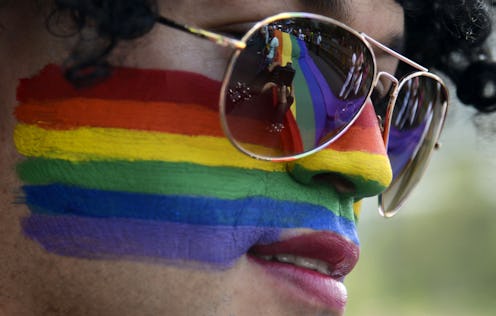Life
Is "Gaydar" Real? Science Says...
If you pride yourself of on having great "gaydar" you will probably be disappointed to know that actually, there's a scientific answer to the question, "Is gaydar real?" — and that answer is, "No." According to a new study, not only is it not real, but moreover, gaydar actually promotes stereotyping. Sorry, guys, but who are we to dispute science?
This new information contradicts previous research, including a much-touted 2008 study that found that people were correctly able to guess whether a man was gay or straight by looking at a photograph. Researchers from the University of Wisconsin-Madison, however, took issue with the study and others like it, noting that many of the photos of gay and lesbian men and women tended to be of higher photo quality than those of the straight people — thus providing another possible explanation for why participants were better able to single out those photos. When the researchers controlled for photo quality, they found that participants weren't able to pick out who was gay and who was straight at all.
But they didn't stop there, either. They also looked at how assumptions about "gaydar" operate relative to stereotypes, and found that actually, the idea of "gaydar" isn't as fun or harmless as you'd think.
“Most people think of stereotyping as inappropriate,” the study's lead author William Cox, an assistant scientist in the Department of Psychology, told University of Wisconsin News. “But if you’re not calling it ‘stereotyping,’ if you’re giving it this other label and camouflaging it as ‘gaydar,’ it appears to be more socially and personally acceptable.”
In one of the experiments Cox and his team conducted, participants were assigned to one of three groups. One group was told that gaydar was real, another was told it was stereotyping, and a third was given no information regarding gaydar. Researchers found that those told gaydar was real were much more likely to rely on stereotypes — such as the idea that gay men like shopping — in trying to determine who is and is not gay.
In other words, gaydar might sound like it's some finely-honed sense based on minute clues your subconscious picks up, but it seems that in actuality it's just using decidedly unsubtle stereotypes. Oops.
And stereotypes are powerful things, as has been shown in studies again and again. Stereotypes impact not only how we see certain individuals in the present, reducing them down to a few qualities, but also what we expect from them in the future. Widespread stereotypes can therefore have a huge influence on everything from a person's career options to their friendships to their physical safety.
There are numerous harmful stereotypes about LGBT people that can be found throughout our culture, from the seemingly innocuous, like the "gay best friend" to the overtly awful, like the idea that LGBT people are a threat to children. But they all have one thing in common — they make it easier to see LGBT people as less than fully-realized, complex human beings. Which is why it's always harmful to make stereotyping seem acceptable.
In other words, we should probably all just stop treating the idea of gaydar as a legitimate thing. I know it's nice to think you have some almost super-natural insight into humanity, but in reality, you're just encouraging your brain to reach for stereotypes when you should just be interacting with people. So it's probably time to let that go.
Images: Giphy (2)
